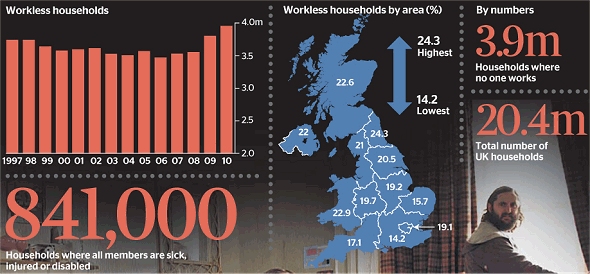|
Four million families where no one works
Sam Fleming Economics Editor
TimesOnline, September 8, 2010
The number of households with no one working has risen to a record high at 3.9 million — or a fifth of the total — government statistics show today.
Of these, some 841,000 are classified as workless because everyone over 16 is classed as sick, injured or disabled, according to the Office for National Statistics. Almost two million children live in homes where no one is employed.
The report, which covers the period from April to June, will increase fears about the culture of welfare dependency that blights many areas. The problem must be tackled if the Government is to bring ing down the welfare bill, which stands at £192 billion a year compared with £132 billion a decade ago.
The figures also reflect the impact of the country’s deepest and longest postwar recession, which has pushed up unemployment and made it far harder for benefit claimants to find work.
Iain Duncan Smith, the Welfare Secretary, is trying to simplify the system and a programme will be introduced next year offering private companies payments to help to get benefit claimants into jobs.
However, there are concerns that investment in welfare reform will come second place to the Treasury’s drive for quick budget savings.
Neil O’Brien, director of the Policy Exchange think-tank, said the figures highlighted the continued drift of jobless people into illness benefits — something that successive governments have failed to resolve. He said: “These numbers look shocking, but it’s worth remembering that they have been high for a long time. There has been a tendency, dating back to the 1980s, for the long-term unemployed to drift onto incapacity and sickness benefits. Labour started to address the problem relatively late in its time in office.”
The figures show that the North East has the highest percentage of workless households, at 24.3 per cent, and the South East the lowest number, at 14.2 per cent. Chris Grayling, Employment Minister, said: “Some areas are suffering from inter-generational worklessness, which is why we must act now to ensure that children in workless households are not left behind like their parents have been.”
Emma Harrison, founder of the private-sector welfare-to-work contractor A4e, said: “This Government will be tougher (on benefit claimants) and it’s the right thing to do, because work is good for people. ” |

